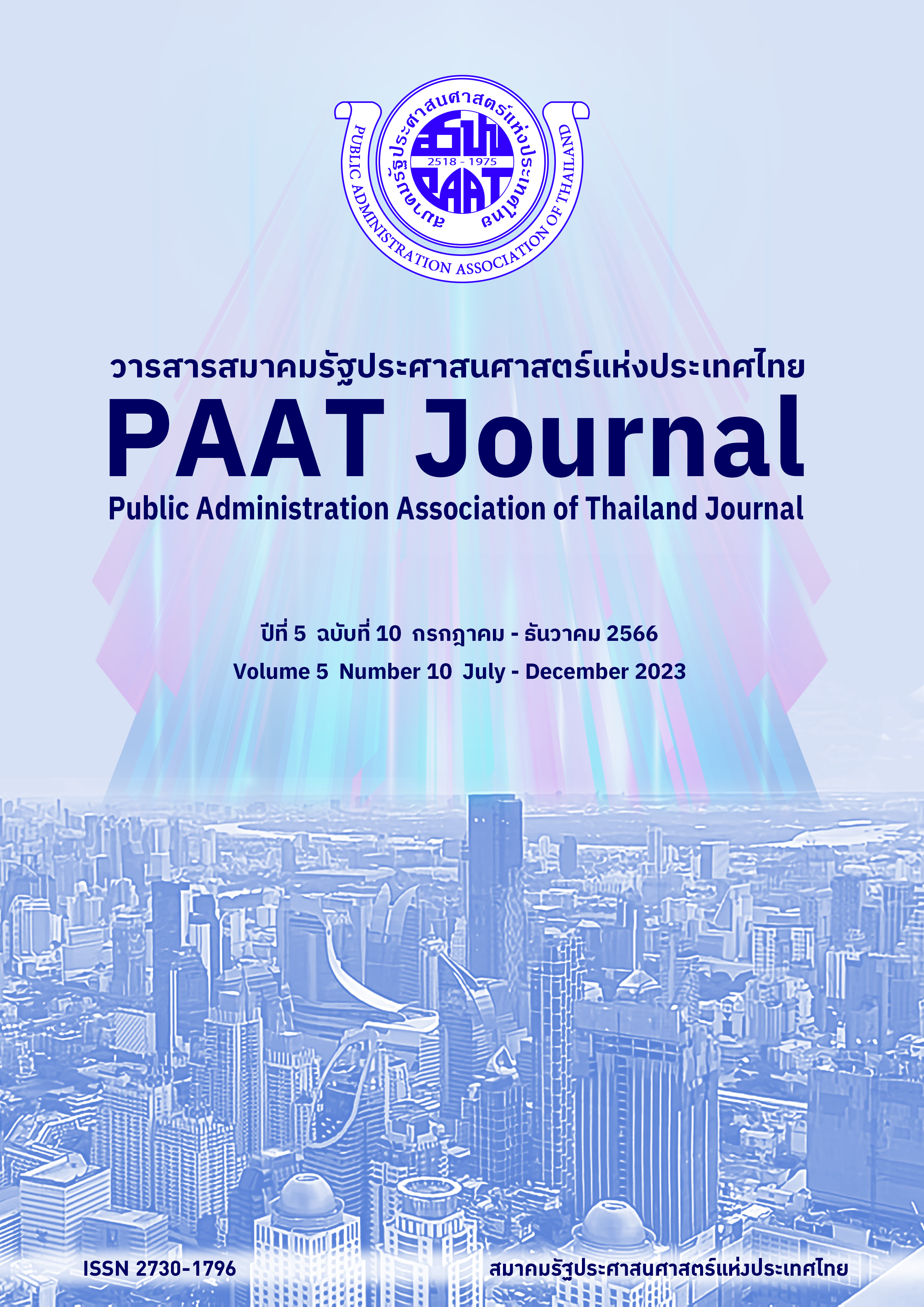การประยุกต์ใช้ปัญญาประดิษฐ์แบบรู้สร้างทั้งในด้านการวิเคราะห์ และการวิจัยในสังคมศาสตร์
คำสำคัญ:
การวิจัยแบบผสมผสาน, ปัญญาประดิษฐ์แบบรู้สร้าง, โมเดลภาษาขนาดใหญ่, การใช้คอมพิวเตอร์ในสังคมศาสตร์บทคัดย่อ
ในยุคที่เทคโนโลยีปัญญาประดิษฐ์แบบรู้สร้างเติบโตอย่างต่อเนื่อง โดยเฉพาะโมเดลภาษาขนาดใหญ่ที่กำลังได้รับความสนใจเป็นพิเศษในการประยุกต์ใช้เพื่อช่วยงานวิจัยในด้านต่าง ๆ บทความนี้วิเคราะห์วิวัฒนาการการเรียนรู้ของเครื่องจักรตลอดจนการถือกำเนิดของโมเดลภาษาขนาดใหญ่ โดยจะเน้นการวิเคราะห์ไปที่โครงการของ DARPA ในการผสมผสานวิจัยคุณภาพและวิธีการคำนวณที่ขั้นสูงโดยเฉพาะผ่านโครงการ Next Generation Social Science (NGS2) และ Ground Truth (GT) ต่อมาโครงการเหล่านี้จะมีพัฒนาการเปลี่ยนเป็นการใช้คอมพิวเตอร์ในสังคมศาสตร์ (Computational Social Science) และกระบวนวิธีวิจัยแบบผสมผสานซึ่งจะรวมวิธีวิจัยเชิงคุณภาพ (QUAL) และวิธีวิจัยเชิงปริมาณ (QUAN) ซึ่งจะทำให้งานวิจัยมีความครอบคลุมหลากหลายมากขึ้น แต่แม้ว่าปัญญาประดิษฐ์แบบรู้สร้างจะมีศักยภาพมาก แต่ยังมีโอกาสที่จะผิดพลาดหรือที่เรียกกันว่าการเกิด “การหลอน” (Hallucination) ในบทความนี้จะพูดถึงมาตรการในการเพิ่มความเที่ยงตรงเรื่องนี้ นอกจากนี้บทความนี้ยังกล่าวถึงตัวอย่างการนำปัญญาประดิษฐ์แบบรู้สร้างมาใช้งานจริงเพื่อตรวจจับแนวโน้มและการสร้างฉากทัศน์แบบอัตโนมัติ
เอกสารอ้างอิง
กอบเกียรติ สระอุบล. (2565). เรียนรู้ AI: Deep Learning ด้วย Python. สำนักพิมพ์ อินเตอร์มีเดีย.
ปริญญา สงวนสัตย์. (2562). Artificial Intelligence with Machine Learning, AI สร้างได้ด้วยแมชชีนเลิร์นนิ่ง. ไอดีซี พรีเมียร์.
Asif, M. A. (2019). Technologies of Power - From Area Studies to Data Science. Journal for Digital Cultures. Spectres of AI, Nr. 5, S. 2019: 1–13. https://doi.org/10.25969/mediarep/13498.
Bengio, Y., Lamblin, P., Popovici, D., and Larochelle, H.. (2006). Greedy layer-wise training of deep networks. In Proceedings of the 19th International Conference on Neural Information Processing Systems (NIPS'06). MIT Press, Cambridge, MA, USA, 153-160.
Cioffi-Revilla, C. (2022). The Scope of Computational Social Science. In Handbook of Computational Social Science: Theory, Case Studies and Ethics, Volume 1, edited by Uwe Engel, Anabel Quan-Haase, Sunny Xun Liu and Lars Lyberg, pp. 17-32. London: Routledge.
De Veaux, R. D. and Eck A. (2022). Machine Learning Methods for Computational Social Science. In Handbook of Computational Social Science: Theory, Case Studies and Ethics, Volume 2, edited by Uwe Engel, Anabel Quan-Haase, Sunny Xun Liu and Lars Lyberg, pp. 291-321. Routledge.
Géron, A. (2017). Hands-On Machine Learning with Scikit-Learn and TensorFlow: Concepts, Tools, and Techniques to Build Intelligence Systems. O’Reilly Media, Inc.
González, R. J. (2022). War Virtually: The Quest to Automate Conflict, Militarize Data, and Predict the Future. University of California Press.
Hinton, G. E., Osindero, S., and Teh Y. W. (2006). A fast learning algorithm for deep belief nets. Neural Comput, 18(7), 1527-54. http://www.doi.org/10.1162/neco.2006.18.7.1527. PMID: 16764513.
Hong QN, Pluye P, Fàbregues S, Bartlett G, Boardman F, Cargo M, Dagenais P, Gagnon M-P, Griffiths F, Nicolau B, O’Cathain A, Rousseau M-C, Vedel I. (2018). Mixed Methods
Appraisal Tool (MMAT), version 2018. Registration of Copyright, Canadian Intellectual Property Office, Industry Canada.
Jacobsen, A. (2015). The Pentagon’s Brain: An Uncensored History of DARPA, America’s Top Secret Military Research Agency. Little, Brown and Company.
Jobin, A., Lenca, M., & Vayena, E. (2019). The global landscape of AI ethics guidelines. Nature machine intelligence, 1(9), 389-399.
King G., Keohane, R. O., Verba, S. (1994). Designing Social Inquiry: Scientific Inference in Qualitative Research. Princeton University Press.
Kublik, S., and Saboo, S. (2022). GPT-3: Building Innovative NLP Products Using Large Language Model. O’Reilly Media, Inc.
Lecun, Y., Bottou, L., Bengio Y., and Haffner P. (1998). Gradient-based learning applied to document recognition. Proceedings of the IEEE, 86(11), 2278-2324. http://www.doi.org/10.1109/5.726791.
Levine, R., Drang, D. E., and Edelson, B. (1991). AI and Expert Systems: A Comprehensive Guide (Second Edition). McGraw-Hill Book Co-Singapore.
Liang, W., Zhang, Y., Cao, H., Wang, B., Ding, D. Y., Yang, X., ... & Zou, J. (2023). Can large language models provide useful feedback on research papers? A large-scale empirical analysis. arXiv preprint arXiv: 2310.01783.
Mahoney, J. (2010). After KKV: The New Methodology of Qualitative Research. World Politics, 62, 120-147. http://doi.org/10.1017/S0043887109990220
Mazzucato, M. (2015). The Entrepreneurial State: Debunking Public vs Private Sector Myths. PublicAffairs.
McCulloch, W.S. and Pitts, W. A. (1943). logical calculus of the ideas immanent in nervous activity. Bulletin of Mathematical Biophysics, 5, 115–13. https://doi.org/10.1007/BF02478259
Morgan, D. L. (2007). Paradigm Lost and Pragmatism Regained: Methodological Implications of Combining Qualitative and Quantitative Methods. Journal of Mixed Methods Research, 1, 48. https://doi.org/10.1177/2345678906292462
Rodriguez, M. Y. and Storer, H. (2019). A computational social science perspective on qualitative data exploration: Using topic models for the descriptive analysis of social media data, Journal of Technology in Human Services. http://doi.org/10.1080/15228835.2019.1616350
Rosenblatt, F. (1958). The perceptron: A probabilistic model for information storage and organization in the brain. Psychological Review, 65(6), 386-408. https://doi.org/10.1037/h0042519
Rumelhart, D., Hinton, G. & Williams, R. (1986). Learning representations by back-propagating errors. Nature, 323, 533-536. https://doi.org/10.1038/323533a0
Russel, S., and Norvig, P. (2022). Artificial Intelligence: A Modern Approach (Fourth Edition) Global Edition. Pearson Education Limited.
Turing, A. (1950). Computing Machinery and Intelligence. Mind, New Series, 59(236), (Oct., 1950), 433-460.
Vaswani, A., Shazeer, N., Parmar, N., Uszkoreit, J., Jones, L., Gomez, A. N., ... & Polosukhin, I. (2017). Attention is all you need. Advances in neural information processing systems, 30.
Woodhouse, I. H. (2021). On ‘ground’ truth and why we should abandon the term. J. Appl. Rem. Sens. 15(4), 041501. https://doi.org/10.1117/1.JRS.15.041501.
Zhao, W. X., Zhou, K., Li, J., Tang, T., Wang, X., Hou, Y., ... & Wen, J. R. (2023). A survey of large language models. arXiv preprint arXiv: 2303.18223.
ดาวน์โหลด
เผยแพร่แล้ว
รูปแบบการอ้างอิง
ฉบับ
ประเภทบทความ
สัญญาอนุญาต
ลิขสิทธิ์ (c) 2023 PAAT Journal (วารสารสมาคมรัฐประศาสนศาสตร์แห่งประเทศไทย)

อนุญาตภายใต้เงื่อนไข Creative Commons Attribution-NonCommercial-NoDerivatives 4.0 International License.



